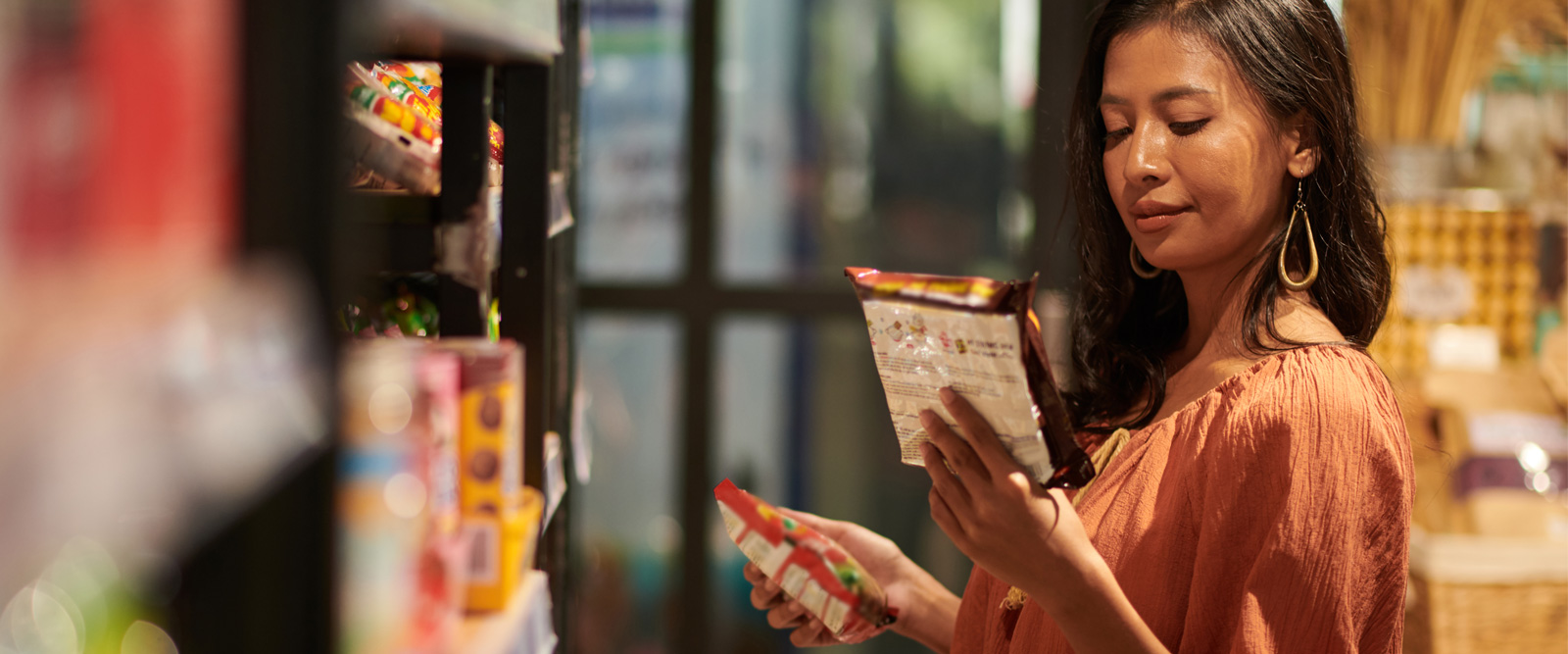Are Processed Foods Bad for You?
An integrative medicine physician explains the difference between minimally processed and ultra-processed foods and their impact on your health.

From yogurt cups to granola bars to frozen vegetables, many staples on a typical grocery list fall into the category of processed foods.
But not all processed foods are created equal. According to recent research published in The Lancet’s eClinicalMedicine journal, regularly eating ultra-processed foods could lead to an increased risk of developing cancer.
The study analyzed the diets of nearly 200,000 people between the ages of 40 to 69. And it found that those who consumed more ultra-processed foods had a higher incidence of developing or dying from several types of cancer over a 10-year period.
Health Matters spoke with Dr. Loy to learn more about how to recognize ultra-processed foods, the possible effects they can have on your overall health, and tips for how to shop and cook with more healthful ingredients.

Dr. Michelle H. Loy
The health impacts of ultra-processed foods are already a widespread concern. “The World Health Organization and the Food and Agricultural Organization recommend the restriction of ultra-processed food as part of a healthy and sustainable diet,” says Dr. Michelle H. Loy, an integrative medicine physician at NewYork-Presbyterian/Weill Cornell Medical Center. “A key takeaway from the study is that a dietary pattern that emphasizes ultra-processed food can be of concern both in the short term and long term.”
What is the definition of processed food?
Dr. Loy: Processed food is defined by the Department of Agriculture as any raw agricultural commodity that’s been washed, cleaned, milled, cut, chopped, or heated. That includes a lot of pasteurized, blanched, canned, frozen, dried, dehydrated, mixed, cooked, and packaged foods.
Processing food may include adding preservatives, flavors, nutrients, and other food substances that are approved for use in food, like salt, sugar and fat. So, it’s basically anything that’s been altered from its natural state.
We also hear more specific terms like ultra-processed and minimally processed. Are there different degrees of processed food?
It’s more like a continuum. An apple from the ground is not processed at all. But if you cut up an apple, or cook it, that’s considered processing it a little bit. Further down the processing continuum you might see applesauce, apple juice, fructose juice concentrate, and apple gummy candy.
Ultra-processed food was defined in 2009, and it’s part of the NOVA classification system that classifies all food into four categories. In the first category are minimally processed foods, like uncut fruits and vegetables. The next category is processed culinary ingredients, things like oils, butter, and sugar. Next is what we call processed food, so things like canned vegetables, smoked meats, freshly baked bread, simple cheeses.
Then, the ultra-processed food category is food made using industrial processes, like carbonation, hydrogenation, molding, pre-frying. It can include foods that contain additives to make it hyper-palatable; preservatives to help it stay more stable at room temperature; or stabilizers to preserve structure. It may also include foods that contain high levels of fat, sugar, salt — and most importantly, in combinations that are not usually found in whole foods.
"While more research is being done to examine how processed foods affect our bodies, we do have plenty of data showing that whole food, unprocessed dietary patterns are all associated with better health."— Dr. Michelle Loy
Why is the processing of foods concerning? Are all processed foods bad for you?
Processing is not necessarily a bad thing. For some foods, like whole grains or oats, processing (i.e cleaning, dehulling, kilning, cutting, steam tempering, flaking and cooling) may be required for consumption and quicker cooking. Fresh fruits like blueberries, pre-cut vegetables, fresh-cut greens, and roasted nuts are also examples of minimally processed foods that can be part of a healthful diet; these are foods that are often prepped for convenience and processed at their peak to lock in nutritional quality and freshness.
Ultra-processed foods, however, are foods that have undergone significant processing and typically contain ingredients that are chemically formulated from food-derived substances. They’re also largely devoid of the foods that occur in their whole form in nature. Examples include sodas, hot dogs, frozen meals, flavored yogurt, instant ramen, potato chips.
Overall, despite often being marketed as healthier diet foods, ultra-processed foods are typically lower in nutritional value, and contain ingredients that are potentially harmful, potentially addictive, or prone to over-consumption.
What has this recent research shown about how ultra-processed foods may impact our health?
Among the Lancet study’s findings was that an incremental 10% increase in consumption of ultra-processed food was linked to a 2% increase in being diagnosed with any cancer, and a 6% increase in dying from cancer of any kind.
Then specifically, with each additional 10% increase in consumption of ultra-processed food, there was shown a 19% increased risk for ovarian cancer and 30% increased risk of dying from ovarian cancer.
The study also found a 16% increase in dying from breast cancer with each 10% increase in consumption of ultra-processed foods.
We have preliminary data from other studies establishing links between ultra-processed food and other things besides cancer, like cardiovascular disease, type two diabetes, and obesity, among others. Today we’re seeing a lot of chronic diseases continue to escalate, and ultra-processed foods may be playing a role.
But while more research is being done to examine how processed foods affect our bodies, we do have plenty of data showing that whole food, unprocessed dietary patterns — which include those from the Blue Zones, the Mediterranean diet, the diabetes prevention diet, the whole plant-based diet, and an anti-inflammatory diet, for example — are all associated with better health.
And that’s probably due to their combination of emphasizing whole foods like vegetables, fruits, whole grains, lentils, beans and nuts, which are full of macronutrients, micronutrients, beneficial phytochemicals, and fiber, in combination with moderating ultra-processed foods.
Recently California banned the use of several ingredients in food products:
- Brominated vegetable oil
- Potassium bromate
- Propylparaben
- Red dye no. 3
Where they’re found: “These compounds are added to many areas of our food supply, so it’s difficult for the average consumer to avoid,” says Dr. Loy. “Red dyes are added to foods for a coloring effect; dyes are often in over-the-counter medications and vitamins. Propylparabens are added to many types of foods including turkey breast, corn tortilla, and candies to improve shelf life; brominated chemicals — which are in brominated vegetable oil and potassium bromate — are used in breads, donuts, pastries, and pizza dough. Potassium bromate is an oxidizing agent and a dough improver; it’s commonly found in bagels, bread, crackers, and doughnuts.”
What to know: “Each of these ingredients has been linked to harmful effects in animal studies and/or human health,” Dr. Loy says. She feels these approved restrictions are a step in the right direction. “This is a public health concern affecting all ages. The public deserves transparency to food and consumer product labeling given the evidence supporting adverse associations between food additives and current and future health.” These restrictions are set to begin in January 2027.
Are there easy ways to tell whether the groceries you’re buying are ultra-processed?
Here are some clues: If there’s a nutrition label, see if there are multiple ingredients listed. Anything with over five ingredients, or with ingredient names that are difficult to pronounce or unrecognizable, should be avoided. I would also recommend people look up the hidden names for sugar, like corn syrup.
And look out for foods that have ingredients added for flavor and texture. These can include jarred pasta sauce, sandwich dressing, yogurt cake mixes, and ready-to-eat foods like crackers, chips, deli meat, frozen foods, and microwaveable dinners.
Also keep in mind that labels like natural, vegan, plant-based, healthy, or low-calorie do not preclude the food from being ultra-processed.
Is it more expensive to buy minimally processed foods?
There is a perception that processed foods are cheap. But with some planning, implementing a whole-foods, unprocessed dietary pattern is very budget-friendly. Try stocking the pantry with minimally processed shelf-stable staples like dried or canned beans, canned vegetables, whole grains, frozen fruits and vegetables, dried nuts, seeds, and relatively inexpensive spices. A pound of dried organic beans that may cost a few dollars a pound can give you nine to 12 servings.
You do have to set aside some time to shop, prep, and cook. But you don’t need as much time as you think. You can cut and roast vegetables and have them for the whole week to put into lunches, dinners, and snacks. Throw canned beans or frozen cooked beans into soups, stews, smoothies, and salads. And when you make beans, you can cook them without flavorings and use them in savory dishes or add them into black bean brownies. For snacks, you can make little bags of nuts mixed with dried fruit and popcorn instead of reaching for a bag of chips.
The return on investment you receive with increased energy and vitality is well worth the swap.

